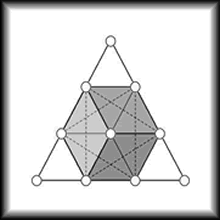The mutual alignment of these ‘complex’ systems - Tarot de Marseilles : Hermetic Qabalah : astrological glyphs : alchemical allegory - could be construed as the product of intentional design, with each system built upon the structure of those which preceded it. As riddles go, the One being discussed qualifies as an Aenigma, though it does have it’s share of conundrums too. The ‘referent’ is an architectural framework in accordance with specific mathematical constants and geometric proportions relevant to both music theory and the synodic cycles of planetary conjunction; all of which are integrated to compose a map of the cosmos and of the self - One in tune with the Hermetic maxim: as above, so below. In an allegorical sense, the journey through this map is akin to an alchemical recipe for taking Lead and turning it into Gold; but the process is not a literal transmutation of metals for the attainment of material wealth.
Like the Ouroboros, it ends where it begins, and begins where it ends. In a very real sense, the key to this riddle is in the transposition of trumps VIII:XI - to such a degree that, looking at it in the context of the whole, One can hardly attribute it to mere coincidence.
Yet, thus far, the questions posed have tended to ask for a justification in presenting such a ‘theory’ without, it seems, an examination of the theory itself. At the risk of repeating myself, the outline given provides a rationale for why Tarot has been called the Book of Thoth. I present it to the Tarot scholars of this forum to accept or refute as they choose - but do so with an understanding of how it works rather than how it threatens the so-called ‘building blocks’ of playing card history.
....................... 2²

Window <------------->

Fishhook 17
....................../....\....................
..................../........\...................
..♃

8______/______\____8 ☿

........\......../..............\....../.........
..........\...../................\..../..........
............\./...................\./............
............/..\................../.\............
........../......\.............../....\...........
..♄

8/_____\_______/____\8☉

....................\........./...................
......................\...../.....................
........................\../.....................
........................ 2³

OX Goad <------->

Serpent
φ = ½(1+√5) = ☉
4:I =




= ☉
. . . . . . . . . . . . . . XIX
. . . . . . . . . . . . . . .☉
10 ☉

--10 ♄

--- X ---10 ♂

--10 ☿

swords--wands--(“4”)---cups---disks
. . . . . . . . . . . . . . . I
. . . . . . . . . . . . . . .☿
. . . . . . . . . . . . . .Ace
. . . . . . . . . . . . . .AIR
. . . . . . . . . . . . . .Ace
. . . . . . . . . . . . WATER
. . . . . . . . . . . . . .Ace
. . . . . . . . . . . . . FIRE
. . . . . . . . . . . . . .Ace
.. . . . . . . . . . . . EARTH
♄-+----->

---------------> 1 ♄ 1
Tempore patet occulta veritas...

 <--------------------------------------√2 diabolus in musica ≈ 11/8
<--------------------------------------√2 diabolus in musica ≈ 11/8
 Window <------------->
Window <------------->  Fishhook 17
Fishhook 17 
 8/_____\_______/____\8☉
8/_____\_______/____\8☉
 OX Goad <------->
OX Goad <------->  Serpent
Serpent